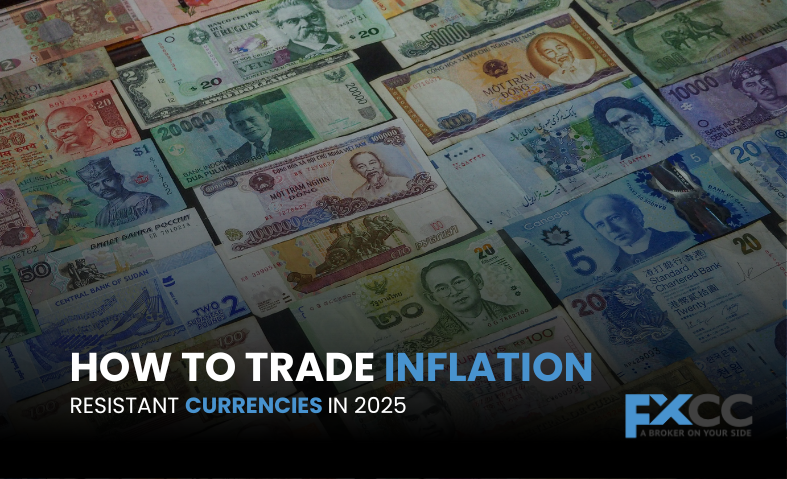Inflation is a major force that shapes the global economy and influences currency markets. When prices rise, the value of money falls, and this can lead to weaker currencies. For forex traders, knowing how to identify and trade currencies that can withstand inflation is key to protecting investments and finding profitable opportunities. In this article, we’ll explore what inflation-resistant currencies are, how to spot them, and strategies for trading them in 2025.
Understanding Inflation-Resistant Currencies
Inflation-resistant currencies are those that maintain or even increase their value during periods of rising inflation. These currencies are typically supported by strong economies, stable governments, and effective monetary policies. They are often seen as safe havens because investors turn to them during times of economic uncertainty or high inflation.

Historically, currencies like the US Dollar (USD), Swiss Franc (CHF), and Japanese Yen (JPY) have been considered inflation-resistant. However, as global markets evolve, other currencies may also gain this status in 2025.
Why Inflation Affects Forex Trading
Inflation has a direct impact on currency values. When a country faces high inflation, its currency usually loses value because the money’s purchasing power decreases. This makes imports more expensive and can weaken the exchange rate. Conversely, countries with low inflation often see their currencies strengthen.
For forex traders, understanding inflation trends is crucial. By focusing on currencies that are less affected by inflation, traders can safeguard their portfolios and potentially profit from market movements.
How to Identify Inflation-Resistant Currencies
Spotting inflation-resistant currencies involves analyzing economic data and observing market behavior. Here are some factors to consider:
- Strong Economic Performance: Look for countries with steady GDP growth, low unemployment, and healthy trade balances. These indicators often point to an economy that can handle inflationary pressures.
- Effective Monetary Policies: Central banks play a vital role in managing inflation. Countries with independent central banks that focus on maintaining price stability are more likely to have inflation-resistant currencies.
- Commodity-Linked Currencies: Some currencies, such as the Australian Dollar (AUD) or Canadian Dollar (CAD), are tied to commodity exports. If commodity prices rise during inflation, these currencies may perform well.
- Safe-Haven Appeal: During global uncertainty, investors often move their money to safe-haven currencies like the US Dollar or Swiss Franc. These currencies tend to hold their value even when inflation is high.
Strategies for Trading Inflation-Resistant Currencies in 2025
Trading inflation-resistant currencies requires a thoughtful approach. Here are some strategies to consider:
- Focus on Safe-Haven Currencies: In times of rising inflation or economic instability, safe-haven currencies like the US Dollar, Swiss Franc, and Japanese Yen often perform well. Consider buying these currencies when inflation is expected to rise.
- Watch Central Bank Actions: Central banks may raise interest rates to combat inflation. Higher interest rates can attract foreign investors, boosting the currency’s value. Pay attention to central bank announcements and adjust your trades accordingly.
- Diversify Your Investments: Avoid putting all your money into one currency. Spreading your trades across multiple inflation-resistant currencies can help reduce risk and increase potential gains.
- Use Technical Analysis: Tools like trend lines, support and resistance levels, and moving averages can help you identify the best times to enter or exit trades involving inflation-resistant currencies.
- Stay Updated on Economic News: Inflation trends can shift quickly, so it’s important to stay informed about global economic developments. Key indicators to watch include Consumer Price Index (CPI) reports, interest rate decisions, and GDP growth data.
Risks to Keep in Mind
While trading inflation-resistant currencies can be rewarding, it’s not without risks. Here are some challenges to be aware of:
- Global Economic Changes: The global economy is interconnected, and a crisis in one region can affect currencies everywhere. Even inflation-resistant currencies can be impacted by global events.
- Overvaluation: Safe-haven currencies can become overvalued when demand is high. This can lead to sudden price drops, resulting in losses for traders.
- Policy Shifts: Central banks may change their policies in response to inflation or other economic factors. These changes can influence currency values and trading strategies.

Trading inflation-resistant currencies in 2025 will require a mix of economic knowledge, strategic planning, and risk management. By focusing on currencies backed by strong economies, effective monetary policies, and safe-haven appeal, traders can protect their portfolios and take advantage of market opportunities. However, staying informed and adapting to changing conditions is essential. With the right approach, trading inflation-resistant currencies can be a valuable part of your forex trading strategy.


